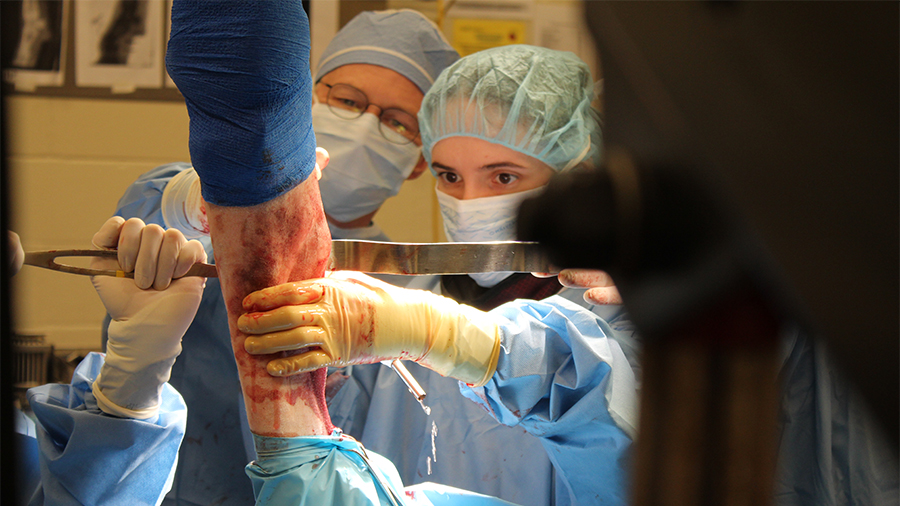ARI research pearls: New HeadsUP cortex screw with larger head could improve equine patients’ quality of life

Horses and other large animals with long-bone fractures could enjoy greater quality of life, thanks to an AO Research Institute innovation. The breakthrough is a new modified 5.5 mm cortex screw with 10 mm head size—known as the HeadsUP screw—that better promotes fracture compression and resistance to the many types of stresses to which such fractures are exposed.
The brainchild of AO Research Institute Davos (ARI) Project Leader Dr Caroline Constant, DVM, grew out of a particular clinical problem faced by AO VET surgeons: repairing condylar fractures of the metacarpus. These are the most common long bone fractures of athletic horses—and the world’s leading cause of euthanasia of thoroughbred horses. Dr Constant, who is both a veterinary surgeon and a holds a master of engineering degree, proposed a solution during her ARI fellowship in 2019 and remained committed to it after she joined the ARI team as a scientist in 2020.
“It was the fact that the head of the currently available large animal screws was smaller in proportion to the shaft, compared to other screws,” Dr Constant explains. With funding from AO VET, the ARI project team started biomechanical testing of the currently available screw and the new modified screw in 2020.
The ARI study, titled “Biomechanical effects of different cortex screw head sizes in equine medial condylar fracture fixation (HeadsUP),” compared the new modified 5.5 mm screw with 10 mm head width (1.8 ratio) to the currently available 5.5 mm cortex screw. The research team—including Dr Constant as well as ARI colleagues Ivan Zderic, Daniel Arens, Brenna Pugliese, Dominic Gehweiler, Boyko Gueorguiev-Rüegg, Stephan Zeiter—hypothesized that the 5.5 mm screw with a nominal diameter-to-head-width ratio of 1.8 would have higher torque in addition to better compressive force, and consequently would allow better interfragmentary compression and higher resistance to failure in shear.
In the in vitro biomechanical study, researchers harvested 15 pairs of cadaveric equine third metacarpal bone (MC3) without orthopedic abnormalities. Computed tomography (CT) examinations were performed to determine bone density. A complete parasagittal lateral osteotomies were created.
Then, one MC3 of each pair was randomly assigned to the modified screw fixation group, while the contralateral MC3 was assigned to the regular cortex screw group. CT examinations were repeated after fracture fixation to assess anatomic reduction and fracture gap at the joint surface and the interfragmentary compression produced by each screw—achieved by maximal hand torque—was assessed. The MC3s were then randomly assigned for biomechanical testing to determine torque to failure, static axial overload, and cyclic failure. The study concluded that the modified 5.5 mm cortex screw with a 10 mm wide head can achieve higher insertion torque and is less susceptible to stripping of the head, in comparison to the existing 5.5 mm cortex screw—and may be able to sustain an increased number of cycles without fracture displacement.
“What this means is that with this modified screw with a larger head, we have the potential to reduce degenerative joint disease in horses and other large animals, and we can improve the chance that athletic horses will run again or even run at a higher level,” Dr Constant explains, adding that the modified screw also has potential use in dairy and beef cattle, sheep, goats, and larger zoo animals such as tigers and bears.
The team’s study has been submitted for publication in Veterinary Journal. Next steps could include investigating whether the modified screw in combination with a plate with larger holes could further improve outcomes for large animals with long bone fractures.

